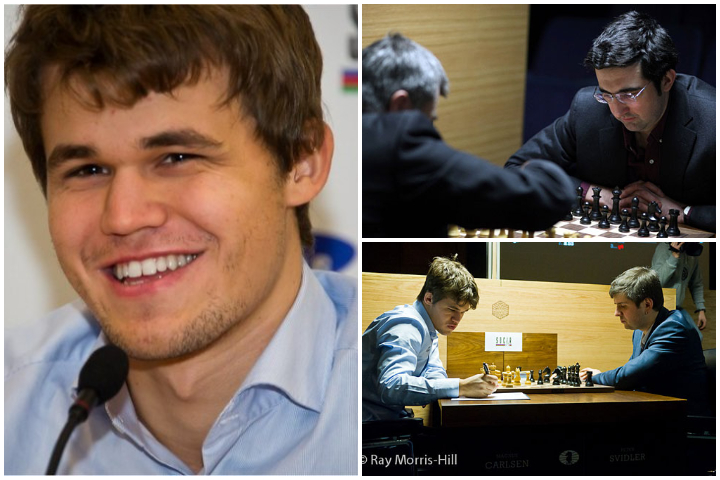A double round robin
After many years of FIDE — under Presiden Kirsan Ilyumzhinov — promising but not finding a way to create a stable and fair World Championship cycle, a big step forward was given in 2013, when the Candidates Tournament was organized as an 8-player double round robin. Magnus Carlsen, who was already the highest-rated player in the world, had twice rejected to participate in Candidates matches previously, but now agreed to take part, arriving in London as the clear favourite.
The tournament took place in the Institution of Engineering and Technology in Savoy Place, a historic building in England’s capital, from March 15 to April 1. The main sponsor was the State Oil Company of the Azerbaijan Republic (SOCAR), and the prize fund shared by the players totalled €510,000.
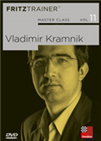 This DVD allows you to learn from the example of one of the best players in the history of chess and from the explanations of the authors (Pelletier, Marin, Müller and Reeh) how to successfully organise your games strategically, consequently how to keep y
This DVD allows you to learn from the example of one of the best players in the history of chess and from the explanations of the authors (Pelletier, Marin, Müller and Reeh) how to successfully organise your games strategically, consequently how to keep y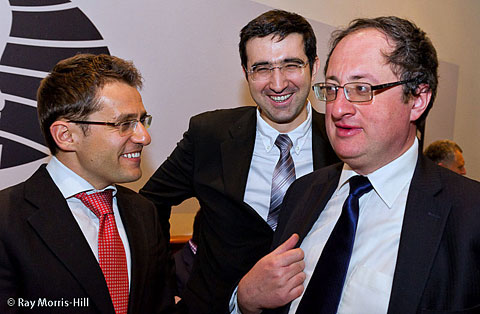
Levon Aronian, Vladimir Kramnik and Boris Gelfand in good spirits

The playing hall
Carlsen and Aronian start strong
While a 22-year-old Carlsen was the favourite, there were doubts regarding his ability to show his best under such pressing circumstances. Moreover, pundits and fans had many reasons to consider Vladimir Kramnik and Levon Aronian completely capable of outperforming the young Norwegian due to their experience in similar competitions.
Carlsen and Aronian drew their first-round encounter, and both won two out of their next three games, becoming the early co-leaders. They continued to fight neck and neck until reaching halftime, with both getting one more win in round 6. The co-leaders had a 1½-points lead over Kramnik and Peter Svidler after round 7.
Standings after round 7
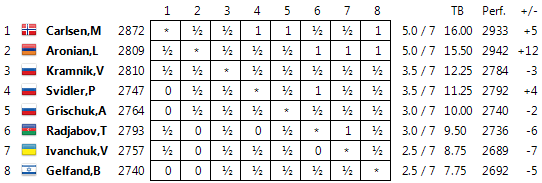
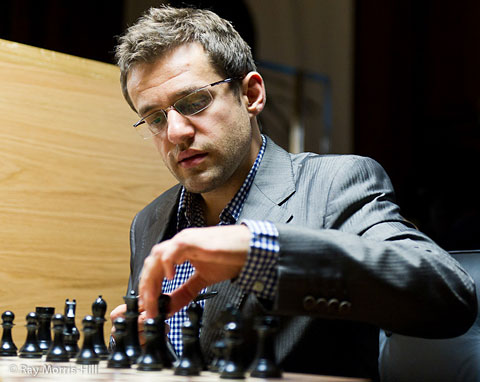
Levon Aronian
Replay all six decisive games played by Carlsen and Aronian in the first half of the tournament with expert analysis.
Select an entry from the list to switch between games
Kramnik’s comeback
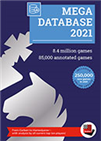 The ChessBase Mega Database 2021 is the premiere chess database with over 8.4 million games from 1560 to 2020 in high quality.
The ChessBase Mega Database 2021 is the premiere chess database with over 8.4 million games from 1560 to 2020 in high quality.By then, the whole narrative of the event was focused on whether the young favourite would manage to outscore Aronian, who had broken the 2800-rating barrier back in 2010 and had been considered as a major contender to get the world title for many years.
But the second half was all about Kramnik, who won 4 out of 5 games from rounds 8 to 12, only drawing Carlsen from the white side of a Catalan in that interim — in round 12, the Russian defeated Aronian by playing a Semi-Tarrasch Defence with the black pieces. In the meantime, the Armenian star had also lost his encounters against Boris Gelfand and Peter Svidler.
Going into the penultimate round, Kramnik was in fact the sole leader. But he was caught up by Carlsen, who beat Teimour Radjabov after the latter cracked under pressure in a minor-piece endgame.
The two top seeds reached the final round sharing the lead, with their closest pursuers unable to catch them. It was a two-horse race.
Standings after round 13

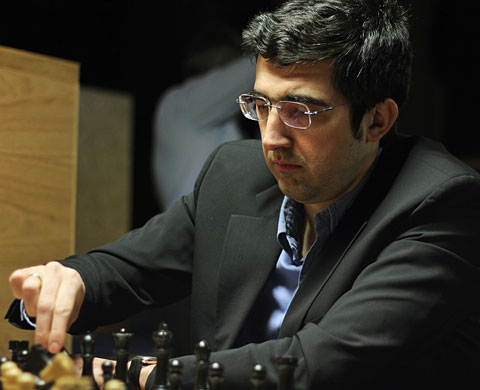
Vladimir Kramnik | Photo: Pascal Simon
Replay all decisive games played by Carlsen and Kramnik from rounds 8 to 13.
A dramatic final round
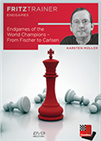 Let endgame expert Dr Karsten Müller show and explain the finesses of the world champions. Although they had different styles each and every one of them played the endgame exceptionally well, so take the opportunity to enjoy and learn from some of the best endgames in the history of chess.
Let endgame expert Dr Karsten Müller show and explain the finesses of the world champions. Although they had different styles each and every one of them played the endgame exceptionally well, so take the opportunity to enjoy and learn from some of the best endgames in the history of chess.Some criticism to the regulations of the tournament was voiced once it was clear how the winner would be decided in case of a tie for first place. The first criterion, which has always been well-received by players and fans alike, was the head-to-head score among tied players. In this case, Carlsen and Kramnik had drawn both their games, so the second criterion would be decisive — the number of wins achieved by each player (or the number of losses, as critics of the system pointed out).
Carlsen had won one more game than Kramnik. The players were tied in points, but the Russian was undefeated with one round to go, while the Norwegian had lost against Vasyl Ivanchuk in round 12. Therefore, a tie would give Carlsen tournament victory; furthermore he had the white pieces in the last round (against Svidler) while Kramnik had black (against Ivanchuk).
The odds were in Carlsen’s favour, but the outcome would have more to do with how the players behaved in this unique, highly-tense situation, as Jeff Sonas explained:
So everything hinges upon the outcome of those two games. It is possible to simulate millions of possibilities, and to quote odds of each player winning the tournament. But these are not as trustworthy because the two games are not independent: obviously Carlsen and Kramnik will be paying close attention to each other’s games, and certainly adjusting their own plans accordingly.
Nerves were at breaking point, and both players ended up losing their games. Carlsen had gained the right to challenge Vishy Anand for the World Championship title.
Final standings

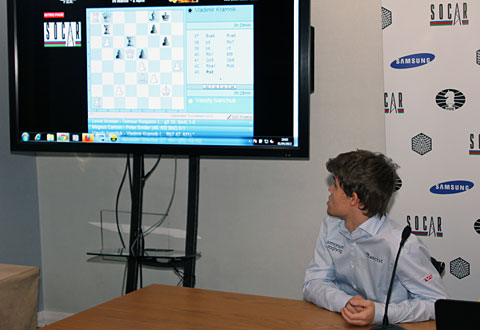
Carlsen at the press conference, while Ivanchuk and Kramnik were still playing
Replay the two games that the co-leaders lost in the final round, analysed by grandmasters Mihail Marin and Daniel Gormally.
Links
